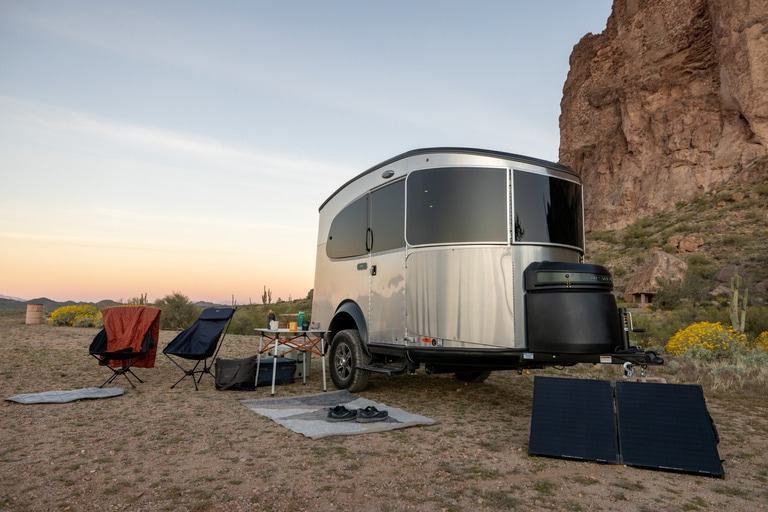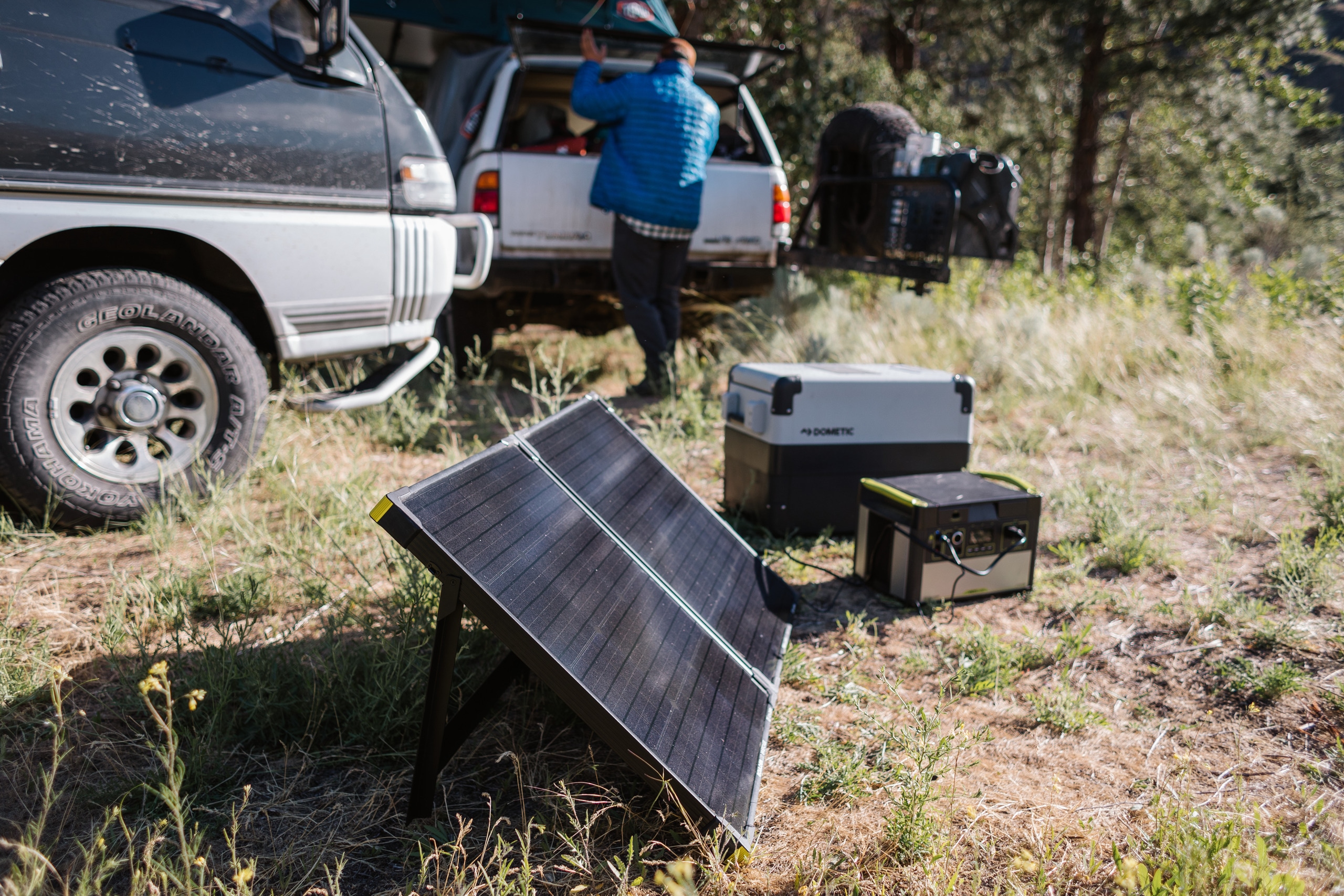Whether backpacking into the wilderness or enjoying van life off the grid, we often head outside to find solitude in nature and disconnect from the stresses of the modern world. But increasingly we also rely on electronic devices such as smartphones, cameras or satellite messengers to help us reach our destinations, enjoy our time there or aid us in case of emergencies.
The use of personal electronic devices in the outdoors continues to grow, creating demand for portable power to recharge them. Portable power devices (also known as power banks or stations, battery packs, portable chargers or battery storage units) house internal rechargeable batteries that allow you to juice up your gadgets on the go.
This article will help you match the portable power technology and solar power that's best suited to your adventure and travel power needs. We'll cover the power supply chain, different types of power sources, types of solar ch argers, and tips for charging your solar chargers.
The Power Supply Chain
By understanding the basic components of the power supply chain, you are well on your way to finding the right technology for your needs.
In short, you need a power source (home power, vehicle power, solar power, etc.) to charge a portable power device (also called power bank, power station, charger, battery pack or storage unit) to then power up your electronic gadget (smartphone, GPS) in the field.
| PowerSOURCE | → | PowerSTORAGE | → | PowerUSE |
Electrical charge supplied to the power bank.
|
| A portable power device to store energy. These can range from a handheld power bank to larger power station capable of running small appliances. |
| Electronic device using stored energy, including: |
Power Sources
Several sources of power can be used to charge up a portable power device or your electronic device directly. The most common sources, from fastest to slowest:
- AC power (wall outlet)
- 12V DC (car charger)
- USB (any source: wall, car, computer)
- Solar panel
- Kinetic motion
- Hydrogen fuel cell
A key to a successful portable power plan is to be sure to charge any batteries and devices from a wall plug or in your vehicle before jumping on the trail. But if you find yourself off the grid and without access to electricity, you have some power options.
Solar energy is the most common off-the-grid source of power available. The photovoltaic (PV) cells on solar panels absorb energy from sunlight and convert it into electricity. This current can be used to charge devices directly or portable power banks. Consider using a solar panel for supplemental energy if your electronics use will exceed the available power stored in a supplemental portable battery. Solar energy is your best option for long trips off the grid when you need to recharge your device multiple times. Read on for more details on how to choose the right solar charger (panel) for you.
Types of Solar Chargers
One of the benefits of solar chargers is that they use a renewable energy source. Portable solar chargers come in different configurations that refer to where the collected power goes once it's converted from sun beams to electricity. Some solar panels fold for easy storage and travel and have built-in stands; others can be mounted.
Several popular solar panel options are available including:

Small/on-device solar chargers: Some personal devices have small, built-in basic solar panels intended to charge the device they are built into, such as a lantern or power bank. These typically need full sunlight to function well. It can take days of direct sunlight to fully charge via this style of panel.

Panel-only solar chargers: These solar panels do not have a place to store the electricity once it's converted. You'll need to buy a compatible portable power bank or power station to convert and store the energy collected. Solar panels can be rigid or folding. They range from medium-sized panels that are compact, lightweight (one to two pounds) and ideal for backpacking, to larger, heavier panels (or an array of them) capable of powering small appliances or for emergency preparedness. Some panels can be plugged directly into your gadgets (phone, GPS, etc.) to charge the internal battery directly, or plug into a separately purchased power bank or portable power station.
Solar panels with integrated batteries: Some solar panels come with power storage capacity by means of a built-in battery. (The BioLite SolarPanel 10+ 2.0 With Onboard Battery is one example). These batteries are typically small and don't hold much electricity, but they usually hold enough to charge up most modern cell phone batteries. This setup works well for individuals who do not need a lot of power.
Tips on Choosing and Using Solar Chargers
What size solar charger do you need? The main variable to consider is how big of a solar panel to purchase for your type of adventure. The larger the panel, the more sunlight it collects at one time and the faster it gets converted to power stored in a battery. This value is measured in watts. The watt value on a solar panel is the maximum power it can deliver under ideal conditions—i.e., when the panels are clean, square to the sun, and there's no cloud cover or shadows on the panels.
Portability and weight: Consider the type of adventure you're taking. Backpackers may want a solar panel that's lightweight and compact enough to fit into their packs. Vehicle-based adventurers may not care as much about weight.
Output capacity: Solar panels are rated in watts. The higher the number, the more electricity is generated during a given period.
Semi-flexible or rigid: Today's portable backpacking-oriented panels are usually a semi-flexible style. They can bend a little but cannot be rolled up like some styles in the past. Most of this style also come with several attachment points to hang them from a backpack or boat to collect solar power while underway—or attach to the tent while at camp to get an optimal angle for capturing sunlight. Some larger overlanding or car camping styles come built into a rigid frame, so they are easier to set up and angle toward the sun or mounted on top of a vehicle but may be harder to turn to track with the sun on its daily transit across the sky.
How will you be traveling? For a solar panel to be effective, it requires lengthy exposure to direct sunlight. Some activities like cycle touring and sea kayaking are well suited to "on-the-go" solar charging. Backpacking in open country can be suitable if you can orient the panel to face the sun. But if you are hiking under a deep forest canopy or through a shadowy canyon, there is not much point in strapping a solar charger to your pack. If you're car camping or boating, big (or heavy) is relatively easy (but pricey). If you're backpacking, how big or heavy of a panel are you willing (and able) to carry?
Weather and other environmental conditions: Will there be enough light? Consider environmental factors like the weather (is your route typically sunny or often cloudy?), as well as the geography and terrain (heavy tree canopies, desert, mountains, canyons, valleys and so on). Solar panels only operate at maximum efficiency under perfect conditions. Cloudy skies, thick fog and other factors limit the amount of solar energy that can hit the panels, and terrain factors like being in a shadowy canyon (does the canyon run east-west or north-south?), under a canopy of trees or in the shadow of a mountain will effectively shorten the amount of sunlight available. While panels will still generate some energy in some shadows, the efficiency drops dramatically.
When are you going? The time of year brings one major factor and two minor factors to solar panel efficiency .
- The major factor is the length of the day which dictates the amount of sunlight available in any 24-hour period. Shorter days in the winter are the main reason to consider getting larger (higher watt rated) panels to make collecting solar energy worthwhile.
- Also consider the angle of light. To collect solar power most efficiently, your panel should be angled perpendicular to incoming sunlight. Your panel must be frequently adjusted as the sun travels across the sky
- One minor factor is how low the sun is in the sky in the winter. When the sun is high in the sky in the summer, the sunlight goes through less atmosphere before reaching the ground (your panels). When the sun stays low in the sky, it has more atmosphere to go through. The atmosphere contains lots of particles (moisture and dust) that block the very photons used to create solar power. Being low in the sky also increases the chances of the sun striking ground-based objects (trees, hills, etc.) and causing longer shadows.
Portable Power Banks and Portable Power Stations
A solar charger is often best used to charge up portable power devices (power banks) rather than the electronic gadget directly. Why? Solar panels often do not have circuitry to regulate the flow of electricity into your electronic device. If you plan to bypass a portable rechargeable power bank, be sure to check the manufacturer's recommendations regarding a regulated USB output for direct charging of small electronic devices.
What's the difference between a power bank and a power station? Storage capacity will determine whether a product is a power bank or power station
Portable power banks refer to smaller units that store power to juice up personal devices such as smartphones. The capacity is measured in milliamp hours (mAh) and provides lower output. They're best for short-term power needs.
- Portable power stations are larger, high-capacity devices that are capable of powering small appliances or serve as emergency backup. They're designed to charge up multiple devices at a time, and often have USB outlets, an AC (standard "wall outlet") outlet, or a 12v outlet.
Key Specs for Portable Power Devices
Storage capacity tells you how much charge the power bank can store for later use to recharge your devices. Capacity is measured in milliamp hours (mAh), Amp hours (Ah) or watt hours (Wh). To convert watt hours to amp hours, use this formula: Wh ÷ Volts = Ah (x 1,000 for mAh).
By comparing the storage capacity of a power bank to that of the battery in your device, you can get an idea of how many recharges you have available. For example, consider a smartphone or GPS unit battery capacity of 3,000 mAh. A power bank with a capacity of 6,700 mAh will provide about two full recharges.
As a starting point, use this formula:
(Device power needs) x (number of needed recharges) = (required power capacity)
iPhone 14 battery capacity 3200 mAh x 2 full charges = 6,400 mAh
Tip: Throw a healthy buffer into your calculations. Transferring energy from one battery to another is not 100% electrically efficient. Thus, a power bank rated at 2,000 mAh will not fully recharge a 1,000 mAh electronics battery twice. Also, reviving a small electronic device from completely dead sometimes takes a little extra electricity to get it going again—another reason the numbers may not match up exactly.
Power output of modern power banks (measured in volts) has for the most part been standardized according to the plug available (USB-A or -C, cigarette lighter outlets, etc.). This is important because the power bank delivery must match the input battery voltage requirement of your electronic device. If it's lower, you may drain your device's battery instead of charging it up. Oops!
Tip: Stick with known and reputable portable power bank brands—like any carried by REI. Cheap knockoffs may not be certified in their voltage delivery and could ruin your device. If the price is too good to believe, this might be why.
Deciding Which Portable Power to Take
Trip duration: For a weekend trip, a portable power bank may be plenty. However once it is used up, it becomes unproductive weight. Off-the-grid trips of a week or more are likely to need a solar charger or other generator.
Tip: Fully charge your devices and power pack right before your trip. Even if you did so a couple of weeks earlier, it doesn't mean they are still holding a full charge.
Mode of travel: For a solar charger to be effective, it requires lengthy exposure to direct sunlight. Some activities like cycle touring and sea kayaking are well suited to "on-the-go" solar charging. Backpacking in open country can be suitable if you can orient the panel to face the sun. But if you are hiking in shaded ares like in the woods or through canyons, a solar charger will not be as effective.
Battery type: If your electronic devices use only AA batteries, consider a solar charger that can boost up a spare set of batteries while others are in use in the device. This way you can rotate two sets of batteries instead of carrying spares.
Tip: Avoid completely draining a device's battery before recharging it.
Size and weight: All chargers take up space and add weight. Is it worth it? Do you need unlimited power no matter what? Or is one emergency charge enough? The bigger (and heavier) a power pack, the more storage capacity it has to provide multiple charges. For solar chargers, consider their built-in attachment points: Can they be tied down or staked out so they don't disappear in a wind gust?
Battery packs offer a supplement, not a guarantee. Do not assume that these products will bring your device's battery up to a full charge.
All rechargeable batteries have a usable life that is usually measured in discharge/recharge cycles. Not all manufacturers provide this figure, but you can assume a battery pack will have a minimum life of 500 cycles, with up to 1,000 cycles being common.

